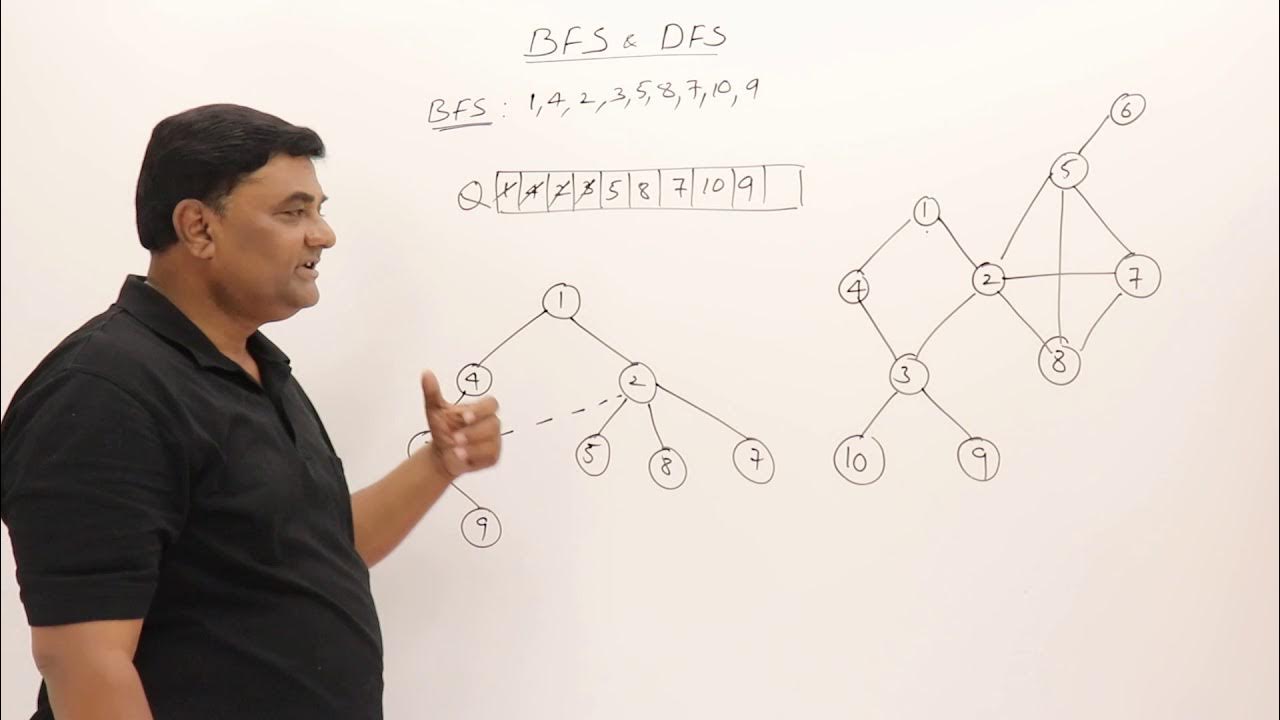DFS -Depth First Seach
Summary
TLDRThis video provides an in-depth explanation of Depth-First Search (DFS), its advantages, and disadvantages, along with its application in programming. DFS is an algorithm used for exploring graphs by diving into one branch fully before backtracking. The video discusses its efficiency in terms of memory usage and its ability to find solutions quickly. However, DFS also has limitations, such as failing to find optimal solutions and potentially getting stuck in infinite loops. A practical example involving the search for the shortest path in a Romanian city map illustrates DFS's behavior and its drawbacks compared to other algorithms like BFS.
Takeaways
- 😀 DFS (Depth-First Search) is an algorithm used for deep exploration of nodes, prioritizing one direction before backtracking.
- 😀 DFS explores nodes from left to right, searching through child nodes first before moving on to other branches.
- 😀 DFS is efficient in terms of memory usage because it doesn't need to store all nodes in memory at once, only the current path.
- 😀 DFS may not always find the optimal solution if better solutions exist at different depths of the tree.
- 😀 One limitation of DFS is that if a tree has an infinite number of nodes, it might not find the solution or can run indefinitely.
- 😀 DFS does not guarantee finding the shortest solution if multiple paths exist, as it prioritizes depth over breadth.
- 😀 When a goal node is found in DFS, it stops searching further, ignoring other potentially shorter paths.
- 😀 In the example with the map of Romania, DFS was used to find a path from one city to another, demonstrating how DFS can miss more optimal routes.
- 😀 The Python implementation of DFS utilizes recursion to traverse nodes, marking visited nodes to avoid revisiting them.
- 😀 DFS can be compared to BFS (Breadth-First Search), where BFS would find the shortest path by exploring all nodes at the same depth before moving deeper.
- 😀 While DFS is effective in memory usage, it can be inefficient when optimality and shortest paths are critical, making BFS a better alternative in such cases.
Q & A
What is Depth-First Search (DFS)?
-DFS is an algorithm used for searching a solution in a tree or graph. It explores nodes by going deeper into the tree, starting from the leftmost child and proceeding to the right once a path is exhausted.
What is the primary strategy of DFS in terms of node exploration?
-The primary strategy of DFS is to explore the leftmost child of a node first before moving to other branches. If a solution is not found, it backtracks and explores the right branches.
What is the advantage of DFS in terms of memory usage?
-DFS requires minimal memory since it only needs to store the current path and visited nodes, making it memory efficient compared to other algorithms like BFS.
How does DFS handle backtracking?
-DFS backtracks when it hits a dead end or does not find a solution at a node. It returns to the previous node to explore other unvisited branches.
What is one major limitation of DFS when dealing with trees or graphs with infinite branches?
-One major limitation of DFS is that if a tree or graph has infinite branches, DFS may run indefinitely or fail to find a solution, as it doesn’t guarantee that all possible paths will be explored.
Why might DFS not always find the optimal solution?
-DFS does not guarantee finding the optimal solution because it focuses on one branch at a time, potentially missing shorter or better solutions found along other branches.
Can DFS find a solution if multiple solutions exist at different levels in the tree?
-DFS might not find the best solution if multiple solutions exist at different levels. It could stop once it finds the first solution, which may not be the most optimal one.
How does DFS perform in the Romania map case study, and what was the outcome?
-In the Romania map case study, DFS concentrated on exploring the left side first, which led to a solution, but it did not find the optimal (shortest) path. The shortest path found using BFS was more efficient.
What are the differences between DFS and BFS when it comes to pathfinding?
-DFS explores one branch deeply before backtracking, which can lead to suboptimal solutions, while BFS explores all nodes level by level, ensuring the shortest path is found in an unweighted graph.
How does the Python code for DFS work, and what does it demonstrate?
-The Python code implements DFS by representing the graph using a dictionary and using recursion to explore unvisited nodes. It simulates the DFS traversal process, printing each visited node and ensuring that nodes are not revisited.
Outlines

This section is available to paid users only. Please upgrade to access this part.
Upgrade NowMindmap

This section is available to paid users only. Please upgrade to access this part.
Upgrade NowKeywords

This section is available to paid users only. Please upgrade to access this part.
Upgrade NowHighlights

This section is available to paid users only. Please upgrade to access this part.
Upgrade NowTranscripts

This section is available to paid users only. Please upgrade to access this part.
Upgrade NowBrowse More Related Video

Depth First Search (DFS) Graph Traversal in Data Structures

AI - Ch03 - Uninformed search algorithms

5.1 Graph Traversals - BFS & DFS -Breadth First Search and Depth First Search

Breadth First Search BFS

Projeto e Análise de Algoritmos - Aula 12 - Algoritmos de busca em largura e profundidade em grafos

Algoritma Dasar Tree
5.0 / 5 (0 votes)